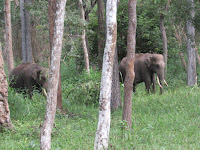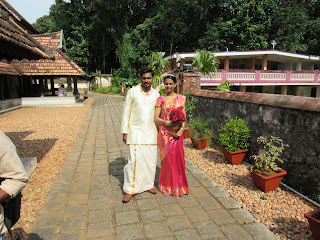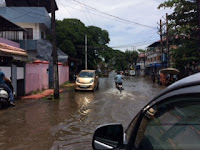Earlier this month we were privileged to be invited to a wedding in Kerala. Not just the
wedding itself but also the preceding customary celebrations. Here is a
description of the wedding formalities and a photos of Honey and Liju’s
marriage.
Indian weddings are vibrant and colourful
celebrations that bring together extended and far-flung family members,
friends, colleagues and neighbours. Filled with rituals the days of the wedding
are lively and energetic with everyone dressed to look their best.
Unlike other cultures, most of the Indian wedding
traditions last more than a day and can sometimes run into weeks. There are
elaborate rituals for preparing the bride and groom before the wedding, for the
wedding day celebrations and for the post-wedding customs.
Finding a Partner
Christians
don’t marry among their relatives so marriages usually begin with a search for
a suitable partner. This commonly starts when a girl is aged 20 to 25, often
after completing a degree, and for boys when they are between 25 and 30.
Unless
possible partners are already known bride / groom wanted advertisements may be
placed in newspapers or a marriage broker engaged. The first step once a
possible union is found is Pennukanal in which the groom along with close
friends and relatives come to meet the bride. If both bride and groom are in
agreement outline details are discussed. In some areas, the bride’s family may
make a return visit to the groom’s home to confirm that everything is okay.
Preliminaries
Once informal
agreement has been reached the bride’s family (without bride) officially visits
the groom’s house to fix the marriage (known as Orappeeru). In the presence of
both sets of relatives the dates of betrothal and marriage are decided. Even
though dowry is not legal, it has now taken a new form – gifts like cars,
property, money or gold ornaments. After a lunch at the groom’s house, the
bride’s family leaves after drinking a customary cup of black tea.
Before the
betrothal, both the bride and groom are expected to attend a compulsory pre-marriage
series of classes held over three days. These cover the entire ambit of married
life and counselling and other classes are given by priests and educated people
in how to live a family life. At the end of the course the necessary certificate
is given for the marriage to take place in church.
Engagement
The next preliminary is that of the betrothal or engagement which is arranged by the bride’s family at her parish church. Betrothal is giving permission in public with both the bride and groom accepting their willingness to marry in front of the church and their relatives and friends. It is usually organised as a small marriage function with the groom and his family bringing a letter from their parish priest.
There is a short
ceremony at church in which both bride and groom is asked their acceptance to
marry. After this, a grand Sadya (a traditional Kerala meal served on a banana
leaf) is served. After lunch, the groom’s family goes to the bride’s home where
the groom is given money to buy dresses. Later, as customary, black tea is
served as a send-off to the groom’s family.
Once the
betrothal is over and before the marriage, the marriage acceptance (Vilichu
Chollal) is announced to the public / parish members of both bride and groom
during mass on three consecutive Sundays. This ensures that there is no
opposition to the marriage.
Before the Wedding
Gold and fine clothes
are purchased for the marriage - usually the gold by the bride’s family and the
marriage saree and manthrakodi by the groom’s family. The marriage saree is normally
cream / golden or white in colour. The manthrakodi is a saree worn by the bride
after the wedding ceremony and later for important family functions. According
to custom, every bride keeps her manthrakodi carefully as this is the first
present that her new family gifts to her, and may ultimately be buried in it.
The manthrakodi
can be of any colour of the bride’s choice and is richly embroidered with gold
and silver threads. 21 threads are carefully taken from it and woven into seven
sets of 3 threads each. It is these threads that are tied around the bride’s
neck as a ‘thali’ during the ceremony. The manthrakodi is given as a sign of
marriage and follows a similar Hindu marriage custom.
The gold
purchases include the wedding rings that are exchanged during the ceremony,
embossed with their names. A gold minnu is purchased by the groom along with a
chain for the bride. The minnu is a leaf shaped gold pendant with a cross
embossed on it. After the wedding it is hung on a gold necklace whose length
should come level with the bride’s heart when worn around her neck. The minnu
and thali are given at the point of marriage and later the minnu is worn as an
indication of a married woman. In a similar way, the bride’s family buy a chain
for the groom.
The other jewellery worn by a bride for her wedding can include traditionally
designed gold earrings, an intricately crafted neckpiece, a pendant worn on a
red thread, a fine gold necklace, a diverse collection of bangles, and a necklace
featuring a heavy pendant that is the highlight of the wedding ensemble.
The night
before the marriage a sweet ceremony (Madhuram Veppu) is conducted at the
bride’s and groom’s homes. The bride / groom is placed on a seat and prayers
are said before a senior relative asks the close relatives present whether the
sweet should be given. The question is asked three times and if no defer the sweet
is fed to the bride / groom. Essentially the ceremony is a get together of all
relatives and friends before the marriage.
The Marriage
The marriage
is usually arranged by the groom’s family at his parish church. In the morning
the bride and groom get ready, say prayers and get blessings from their family elders.
They are then taken to the church with the bride arriving first and then the
groom. Little flower girls carrying flower baskets walk ahead to the altar
followed by the bride, groom and their family members. Different baskets
containing fruits, flowers etc are carried into the church. These are a symbol
of prosperity and well-being.


Of all the Keralan Christian weddings, the catholic ceremony is the most
solemn. There is no frivolity or excess of music that take away the
auspiciousness of the occasion. The marriage itself is conducted after a holy
mass. The bride and groom present themselves before the altar with their family
members standing behind them followed by the rest of the guests. Throughout the
ceremony, the entire congregation, numbering 100 to 500, stand with the women covering
their heads with a scarf or the pallu of their saree. The thali, made using threads
from the manthrakodi, the wedding rings, chains and rosary are placed on a tray
in front of the altar.


The bride and groom stand before the altar and light a lamp. The priest
then reads verses from the Bible which are sometimes chosen by the bride and
groom beforehand. He also speaks much about the relevance and importance of
marriage, linking it to many contemporary issues. Thereafter the couple is
directed to hold their right hands and make solemn affirmation to remain in
life-long loyalty to each other and remain as one in thick and thin.
After this is Minnukettu, the most important ritual of a Kerala
Christian marriage. The bride kneels in front of the groom, facing the altar. The
priest blesses the manthrakodi and gives it to the bridegroom who drapes it over
the bride’s head. The priest then dips pieces of holy bread in wine and gives
it to the bride and groom followed by the family members.
The minnu is blessed and the priest hovers it around the couple’s heads
in the form of a crown. This is repeated three times and the couple is crowned
King and Queen of their new life together. The groom ties the thali around the
bride’s neck and rings are exchanged. After all the formalities are over the
priest directs the couple to drink from a single tender coconut simultaneously using
two straws.
On completion of the rituals the bride and groom take the oath of
marriage and sign the register.
The Wedding Feast
Once the ceremony
is over the bride and groom make offerings to the church before being led to
the grand feast of marriage. Here they light candles and cut the cake before
feeding it to each other and to close relatives. The cake, which has been a
part of wedding celebrations since the Roman times, is a symbol of good luck
and fertility. The sharing of this food symbolizes the couple’s willingness to fulfil
each other’s needs, creating a simple yet strong bond.
It is also
traditional for them to drink tender coconut water but frequently this may be
champagne. As the liquid is poured the bride and groom make wishes for their
good fortune, a better future and the best life possible for themselves. Once
the feast starts, the bride changes her wedding dress from the marriage saree
and puts on the manthrakodi.
For the
wedding feast or sadya there is often a minimum of 20 dishes, though the count
can go as high as 40, complete with dessert and fruit. Served on a banana leaf
the dishes typically include pickle, thoran, avial, sambar, dal, meat and fish
curries, pappadam and rice as well as other dishes. Ice cream is a popular
desert.
Aftermath
Later after
the feast, everybody gathers at the groom’s home where his mother welcomes the
bride and groom by blessing them and giving them a rosary as a memory of their
marriage. The bride and groom are given sweetened milk and sweets.
Finally the
bride is handed over to the groom’s mother by her mother. Her mother will also
give a gold chain to the groom and in return he will gift a saree back to the
bride’s mother. Lastly, as is customary, black tea is served before the bride’s
family leaves with the bride remaining at the groom’s house.
The day after
the marriage a series of ceremonial family visits (virunnu) commence. Both bride
and groom are invited by their respective relatives to visit their homes where
they are treated to mouth-watering dishes, a process that can last for months!
And thus a splendid
Keralan wedding draws to an end.


















































